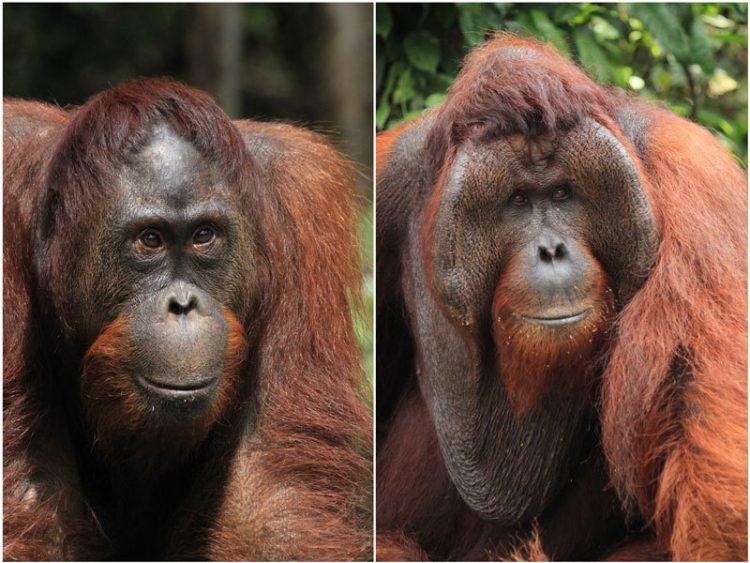Orang-utan females prefer cheek-padded males

Subordinate orang-utan male without cheek pads (left) and dominant male with cheek pads (right), Tanjung Puting National Park, Indonesia. Bpk Bain
Unlike most mammals, male orang-utans express one of two distinct morphological forms: some develop large “cheek pads” on their faces; others do not. A team of researchers led by Graham L. Banes and Linda Vigilant of the Max Planck Institute for Evolutionary Anthropology in Leipzig, Germany, studied the reproductive success of Kusasi, the former dominant male at Camp Leakey in Indonesia’s Tanjung Puting National Park and compared it with that of socially subordinate, non-cheek-padded males from the same area.
To this aim the researchers collected faecal samples and performed paternity testing. They found that, during his decade as “king” of the jungle, Kusasi fathered significantly more offspring than any other male. Only during periods of rank instability, in the beginning and at the end of Kusasi’s dominance, did other males succeed in fathering offspring. The findings are published in the journal Behavioral Ecology and Sociobiology.
Typically, only one male orang-utan in any given area – the dominant one – has cheek pads. Along with increased body size and a large, pendulous throat sac – used to bellow resonant 'long call' vocalizations – these cheek pads are characteristic of dominant males, and are suspected to make them more attractive to females, resulting in greater reproductive success compared to non-cheek-padded rivals. But males without cheek-pads are also known to be capable of fathering offspring.
“Dominant males have to find and consume more calories, their movement is restricted as a result of their size, and fights with neighbouring dominant males have been known to result in death”, says Graham L. Banes, a post-doctoral scientist at the Max Planck Institute for Evolutionary Anthropology, who began this longitudinal study at the University of Aberdeen, later moving to the University of Cambridge. “So, why would a male develop cheek pads if he can father offspring without?”
To answer this question, Banes spent eight years studying the orang-utans of Tanjung Puting National Park, twice following their movements for several months at a time from dawn till dusk, collecting faecal samples from all orang-utans observed in the 50 km² study area. The researchers extracted DNA from these samples and identified 39 known individuals, including 12 males.
“We performed paternity testing to see which of these males were fathering offspring at Camp Leakey, and to quantify Kusasi’s reproductive success, compared with that of other, non-cheek-padded males”, says Linda Vigilant of the Max Planck Institute for Evolutionary Anthropology. “Paternity could be assigned to 14 candidate offspring, conceived across multiple decades, ten of which were fathered by Kusasi.”
The results show that Kusasi fathered many more offspring than any other male during his tenure as dominant male, potentially as a result of his cheek pads attracting female orang-utans. As expected, non-cheek-padded males were also shown to have achieved paternities. “The timing, however, was interesting”, says Banes. “These other males were typically reproductively successful at the beginning and end of Kusasi’s dominant period, when the hierarchy was potentially unclear.”
From this, the authors conclude that cheek pad development is an evolutionarily stable strategy: reproductive success is significantly skewed in favour of dominant, cheek-padded males, while other males simply bide their time until periods of rank instability.
Contact
Dr. Graham L. Banes
Max Planck Institute for Evolutionary Anthropology, Leipzig
Phone: +86 131 221-02502
Email: graham_banes@eva.mpg.de
Dr. Linda Vigilant
Max Planck Institute for Evolutionary Anthropology, Leipzig
Phone: +49 341 3550-222
Email: vigilant@eva.mpg.de
Sandra Jacob
Press and Public Relations
Max Planck Institute for Evolutionary Anthropology, Leipzig
Phone: +49 341 3550-122
Fax: +49 341 3550-119
Email: info@eva.mpg.de
Original publication
Graham L. Banes, Biruté M. F. Galdikas & Linda Vigilant
Male orang-utan bimaturism and reproductive success at Camp Leakey in Tanjung Puting National Park, Indonesia
Behavioral Ecology and Sociobiology, 01.09.2015, DOI: 10.1007/s00265-015-1991-0
Media Contact
All latest news from the category: Life Sciences and Chemistry
Articles and reports from the Life Sciences and chemistry area deal with applied and basic research into modern biology, chemistry and human medicine.
Valuable information can be found on a range of life sciences fields including bacteriology, biochemistry, bionics, bioinformatics, biophysics, biotechnology, genetics, geobotany, human biology, marine biology, microbiology, molecular biology, cellular biology, zoology, bioinorganic chemistry, microchemistry and environmental chemistry.
Newest articles

High-energy-density aqueous battery based on halogen multi-electron transfer
Traditional non-aqueous lithium-ion batteries have a high energy density, but their safety is compromised due to the flammable organic electrolytes they utilize. Aqueous batteries use water as the solvent for…

First-ever combined heart pump and pig kidney transplant
…gives new hope to patient with terminal illness. Surgeons at NYU Langone Health performed the first-ever combined mechanical heart pump and gene-edited pig kidney transplant surgery in a 54-year-old woman…

Biophysics: Testing how well biomarkers work
LMU researchers have developed a method to determine how reliably target proteins can be labeled using super-resolution fluorescence microscopy. Modern microscopy techniques make it possible to examine the inner workings…





















